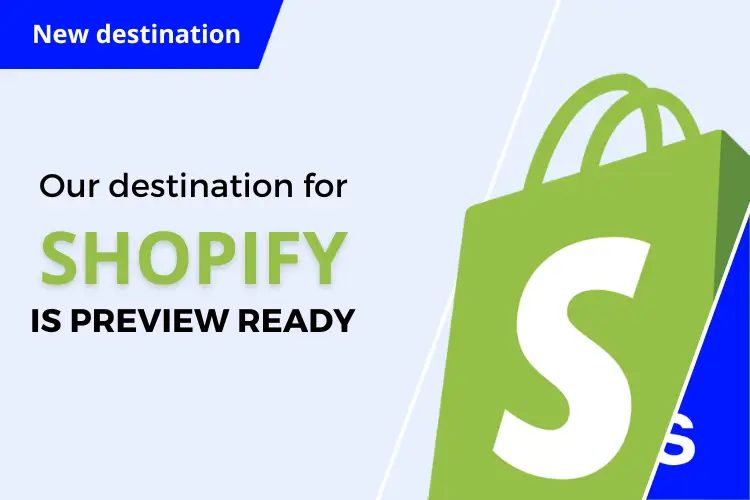For what feels like forever, we've been helping businesses move data seamlessly with our destinations. In early 2024, we officially launched them, and now we’re excited to introduce the preview for our most advanced destination yet: the Shopify Destination.
Shopify has long been the go-to platform for small and medium-sized businesses, and increasingly, enterprises are choosing it for their e-commerce needs. With the Enterspeed Shopify Destination, any business can now leverage our data orchestration to send products directly into Shopify – efficiently, reliably, and at scale.
Want early access? Just book us here and we'll get you set up 🫡
Why a Shopify integration matters
You might be asking: why is a Shopify integration such a big deal? Why not just send your data into Shopify directly?
Shopify’s API is complex, and for good reason. Managing server-to-server integrations is rarely simple, and keeping everything in sync across endpoints can quickly become overwhelming. That’s exactly why we built the Shopify Destination: to handle the complexity for you.
Instead of spending time worrying about rate limits, pagination, GraphQL quirks, asynchronous workflows, and frequent API version changes, you can focus on managing your products while Enterspeed ensures the data flows smoothly into Shopify.
Multiple Shopify shops
Do you manage multiple Shopify shops with overlapping product assortments?
Our Shopify Destination makes that easy. Each Shopify shop is treated as an individual destination, and you can define custom logic to determine which products go to which shop. This allows you to maintain consistent product data across multiple stores without duplicating effort or introducing errors.
We handle the hard stuff
Shopify’s API is powerful but complicated. Product data can span multiple endpoints – products, variants, inventory levels, media, meta-fields collections, and translations – each with its own schema, pagination, and rate limits. Add in asynchronous updates and frequent API version deprecations, and maintaining a robust integration can quickly become a full-time job.
Our integration with Enterspeed acts as a simplified destination layer: we ingest and normalise Shopify product data once, giving you a clean, stable interface while managing all the underlying complexity behind the scenes.
How it works
The integration workflow begins with a custom application that interfaces with your source system, whether that’s structured Excel files, ERP, or PIM systems. This application extracts the relevant product data and pushes it to the Enterspeed Ingest API, leveraging built-in change detection to identify updates while maintaining its own state to track which products need deletion.
Once ingested, the data is transformed into Shopify’s data model within Enterspeed using JavaScript schemas, guided by Shopify’s product schema to ensure structural and type consistency. Finally, the processed payloads are forwarded to Shopify’s Ingest API, completing the end-to-end pipeline from the source system to Shopify in a deterministic and auditable manner.

This approach ensures that businesses of all sizes – whether managing a single store or multiple Shopify shops – can keep product data accurate, consistent, and up to date without needing to wrestle with the intricacies of Shopify’s API themselves.
Ready to get started with early access? Book us here and we'll get you sorted 🫡

More glue: Introducing Enterspeed Destinations

We often describe Enterspeed as glue, and we are proud of it. The primary use case for Enterspeed is high-performance APIs, but in the last two years, we have been building a growing number of what we call Destinations. Using Enterspeed Destinations allows you to easily integrate with third-party services such as Algolia or Relewise, or build your own custom integrations using webhooks or an Azure Service Bus.

Destination Logs: What to do when things go wrong?

Destinations is our name for when you configure Enterspeed to push data to other systems. Since its introduction a couple of years ago, we have seen more and more use. We are now seeing some sophisticated integration scenarios being handled in Enterspeed. And honestly, our tooling for debugging these scenarios was close to non-existent. We are now changing this, which makes us really happy because then our users will be happier (plus we will have fewer support messages...).

Destinations: Webhook vs. Service Bus. Which one should you choose?

It’s been about a year since we introduced the concept of Destinations in Enterspeed. Back then, webhook was our very first Destination, but now we've introduced Azure Service Bus as Destination too. So, which one should you use in your project?

20 years of experience with web technology and software engineering. Loves candy, cake, and coaching soccer.

